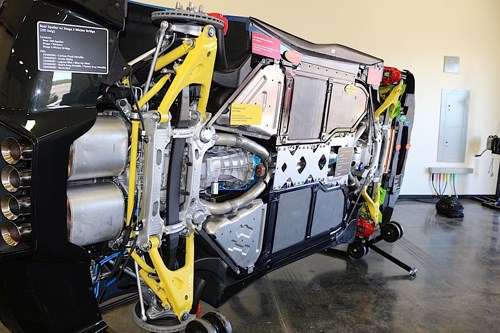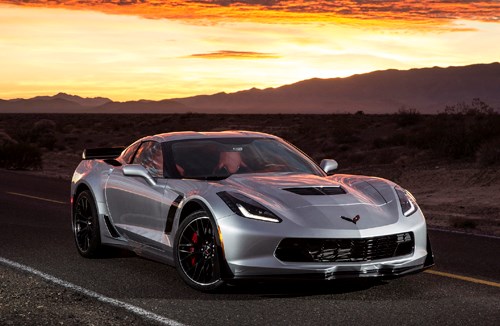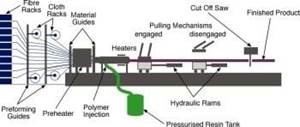For the Corvette, a smooth ride depends on composites
On a vehicle already famous for having a long history of composites use, finding a new part on which to apply the material is a challenge, but PolyOne’s Advanced Composites Glasforms unit managed to do just that.

Underbody braces for the Corvette C7, made via pultrusion and overwrapped carbon fiber fabric.
On a vehicle already famous for having a long history of composites use, finding a new part on which to apply the material is a challenge, but PolyOne’s Advanced Composites Glasforms unit managed to do just that with the underbody braces designed for the C7 generation Corvette, manufactured by General Motors (GM).
Ben Hochman, director of marketing at Glasforms, says he and his team had been meeting with GM engineers and discussing material and technical challenges on the Corvette. The topic of underbody braces came up. GM wanted to get away from the steel braces traditionally used and had developed an aluminum alternative that, unfortunately, was somewhat lacking in flexural stiffness. The result, says Hochman, was a less-than-optimal driving experience.
GM then turned to composites, but the challenge was developing the mechanical properties in all directions that the company required. And that’s where Glasforms stepped in.
There are four underbody braces on the Corvette — one associated with each wheel. Each brace is about 2 ft long, 1.25 inches wide, 0.375 inch thick, and notched at each end to accommodate metallic fasteners. The braces are designed to reduce chassis sway and confer greater stability in vehicle handling, giving a tighter “feel” to the driving experience. Basically, as underbody brace stiffness increases, so does handling stiffness. The “feel” of the Corvette has been highly developed by GM, and is expected by drivers. A composite underbody brace must, therefore, allow the Corvette to continue to meet that expectation.

Underside of Corvette. The braces are the black, narrow, diagonally oriented rods running from the outside edge of the vehicle toward the yellow wheel suspension system.
Hochman says Glasforms settled on an underbody brace design that would use a carbon fiber/epoxy composite manufactured via pultrusion. Pultrusion offers a constant cross-section, high stiffness and good longitudinal fiber alignment. What a pultruded part lacks, however, is good transverse strength. To manage that, says Hochman, “We developed three design scenarios for the brace, mixing and matching torsion and flexural stiffness.”
- A unidirectional, hybrid carbon and glass fiber profile
- A unidirectional carbon fiber profile
- A profile made with a unidirectional carbon fiber and a transverse engineered fabric, which had the advantage of minimizing potential cracks from propagating.
Testing at Wichita State University showed that the first option was an estimated 33% lighter than the aluminum part, with a 36% increase in flexural stiffness. The second option was estimated to be 41% lighter than the aluminum part, with a 100% increase in flexural stiffness, but a large reduction in torsional rigidity. The third profile was also 41% lighter than aluminum, with a 50% increase in flexural stiffness, and maintained torsional rigidity slightly better than that of aluminum.
GM engineers chose this third option because it met all of the technical requirements and had the best combination of properties.
The resulting brace assemblies, ultimately 17% lighter than their aluminum competitors, were delivered to GM for vehicle shake and road testing. They were validated and now are an upgrade option on the C7 Corvette.

Glasforms does all carbon fiber underbody brace manufacturing and has, says Hochman, “seen an increase in interest since the product’s release. The discerning buyer is very intrigued by the performance properties of these braces.”
Looking ahead, Hochman believes the braces have application on other vehicle platforms. He thinks Glasforms’ knowledge on composite design and manufacture will allow the company to adapt easily to other structural applications in automotive composites.
Related Content
Composite rebar for future infrastructure
GFRP eliminates risk of corrosion and increases durability fourfold for reinforced concrete that meets future demands as traffic, urbanization and extreme weather increase.
Read MoreRobotized system makes overmolding mobile, flexible
Anybrid’s ROBIN demonstrates inline/offline functionalization of profiles, 3D-printed panels and bio-based materials for more efficient, sustainable composite parts.
Read MoreBiocomposite for mobile architecture, low load-bearing applications
The German Institutes of Textile and Fiber Research and partners have developed a biocomposite well suited for support profiles and connecting nodes in construction applications.
Read MorePultrusion: The basics
A primer describing what pultrusion is, its advantages and disadvantages, and typical applications.
Read MoreRead Next
From the CW Archives: The tale of the thermoplastic cryotank
In 2006, guest columnist Bob Hartunian related the story of his efforts two decades prior, while at McDonnell Douglas, to develop a thermoplastic composite crytank for hydrogen storage. He learned a lot of lessons.
Read MoreCW’s 2024 Top Shops survey offers new approach to benchmarking
Respondents that complete the survey by April 30, 2024, have the chance to be recognized as an honoree.
Read MoreComposites end markets: Energy (2024)
Composites are used widely in oil/gas, wind and other renewable energy applications. Despite market challenges, growth potential and innovation for composites continue.
Read More

























